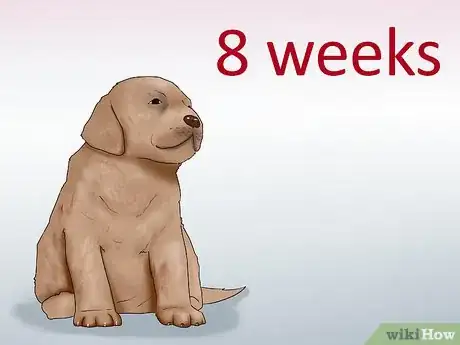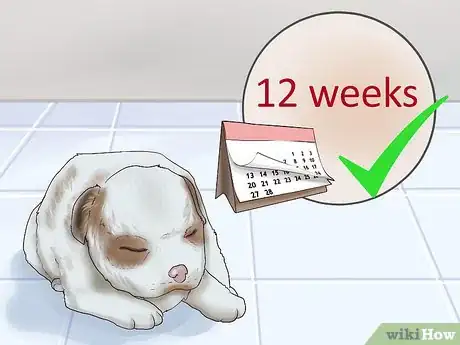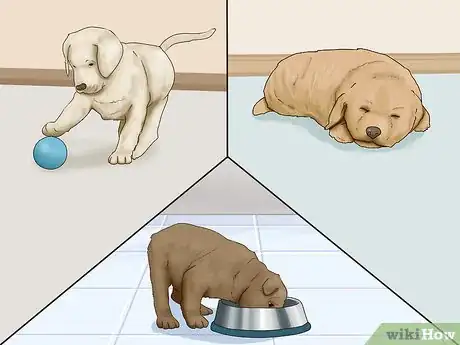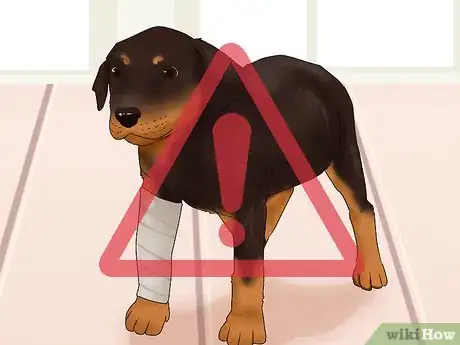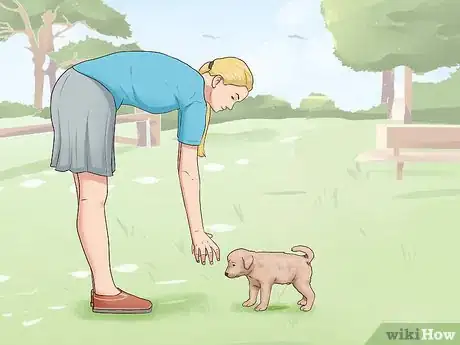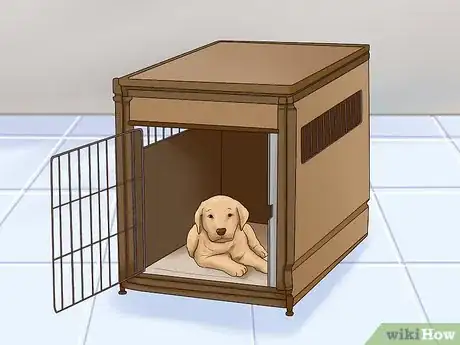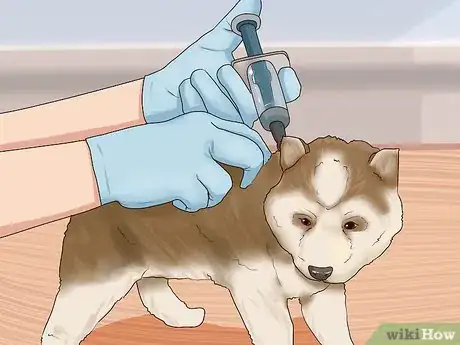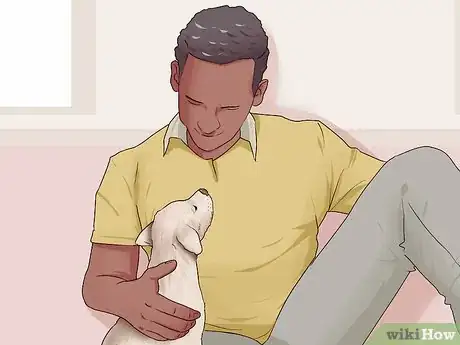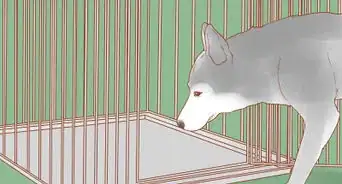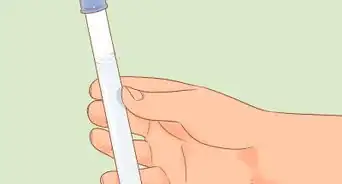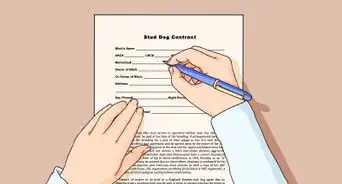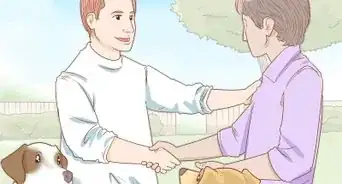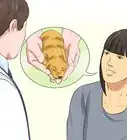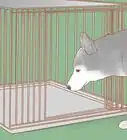This article was co-authored by Lauren Baker, DVM, PhD. Dr. Lauren Baker is a Veterinarian and Assistant Scientist at the University of Wisconsin-Madison. With over 10 years in veterinary medicine, she specializes in the concept of “one health,” which uses insights from veterinary medicine to help human medical research. She holds a Ph.D. in Comparative Biomedical Sciences, a Doctor of Veterinary Medicine, an MS in Comparative Biomedical Sciences, and a Bachelor’s degree in Psychology from the University of Wisconsin-Madison.
There are 7 references cited in this article, which can be found at the bottom of the page.
This article has been viewed 19,862 times.
Taking care of puppies is one of the most rewarding and challenging experiences any pet owner or breeder may encounter. The biggest challenge, ultimately, is figuring out when puppies are ready for new homes. Not only do you need to take into account biological factors such as age, but also a wide range of social and developmental factors. Thankfully, by socializing the puppies, making sure they’ve met major milestones, and factoring in problems associated with specific dogs or breeds, you’ll be able to know when puppies are ready for their new homes.
Steps
Evaluating the Puppy's Overall Development
-
1Keep the dog for about eight weeks. Early adoption presents many risks for newborn puppies. Perhaps the most important thing to consider when it comes to homing a puppy is that the dog must have the time to go through all of its developmental stages before settling into its forever home. Without enough time, dogs may exhibit behavioral problems.
- Veterinarians and breeds typically recommend waiting until week 8 before homing a dog.
- Separating a dog early may result in the dog developing separation anxiety.
- Dogs homed earlier than 8 weeks often exhibit behavior problems including destructiveness, excessive barking, inability to be house trained, or aggression.[1]
- If you want to vaccinate, deworm, socialize, and train the puppy before finding it a new home, it's OK to keep it with you for up to 12 weeks instead 8.
-
2Delay your schedule for smaller dogs. Smaller dogs are often more fragile than other dogs and may need a longer time to move through developmental stages.
- Some dogs that may need a delayed schedule include: chihuahuas, Yorkshire terriers, and pugs.
- Breeders will sometimes delay homing of small dogs until 12 weeks.[2]
Advertisement -
3Judge the puppy's independence. An independent puppy is one that will be able to handle the physical, emotional, and social pressures that come with the homing process. Without a certain level of independence, puppies may develop behavioral issues that stay with them throughout life. Make sure:
- The puppy is not emotionally dependent on its mother. This means the puppy has been separated from its mother for a substantial amount of time -- at night and during the day. For instance, the puppy has slept on its own (or with littermates) apart from the mother.
- The puppy has had substantial interaction with humans and animals outside of its mother and littermates.
- The puppy is physically independent. This means it can eat, walk, and play without constant supervision.[3]
-
4Consider traumas that may have impacted the puppy's development. In some cases, puppies might need more than 8 weeks before they’re adopted out. Ultimately, you’ll need to evaluate the dog and come to a judgement about their development. Important factors delaying adoption may include:
- The mother dog passed away.
- The puppy experienced some sort of trauma or medical problem such as an injury sustained by another dog or a sickness or illness.
- The dog has exhibited some sort of developmental issue or has been delayed in weaning, potty training, crate training, or other milestones.
- Always base the timeline of homing a puppy on the individual dog – if it needs more time, provide it. If you rush the homing process, the dog may develop behavioral problems.[4]
Meeting Major Milestones
-
1Wean the puppy. Weaning is the process in which a person transitions a puppy from their mother’s milk to solid food. Ultimately, the weaning process is one of the most important stages of a puppy’s development.
- Weaning usually occurs between week 3 and 5.
- This process takes from days to several weeks.
- Start weaning by providing milk replacer for one meal a day. After you’ve experienced success, provide the puppy with soft food mixed with water or milk replacer. Gradually decrease the amount of water and milk replacer you mix in over the course of a week until the puppy is eating only dry food.
- A puppy must be weaned before being adopted out.[5]
-
2Potty train the puppy. Potty training is the process in which you teach a new puppy to only go to the bathroom in a certain location. Since most puppies will be house pets, potty training is an essential thing to work on before adopting a puppy out.
- Put the puppy on an outside schedule. Puppies between 4 and 6 weeks should be allowed to go outside every 1-2 hours. Puppies can usually hold their bladder for about 1 hour for every month old they are.
- Use puppy pee pads or training paper to demarcate areas where puppies may go to the bathroom.
- Crate training reinforces potty training, as dogs don’t want to mess in the area they sleep. If you find a puppy doing so, you need to take them outside more often.
- Don’t yell at a puppy because they messed inside or in their crate. It may take weeks to potty train them.[6]
-
3Crate train the puppy. Crate training is the process in which a new puppy – and their littermates – are introduced and acclimated to crates. This is important, as dogs may wind up staying in their crates substantial amounts of time after they are homed.
- Crate training is typically done between 5 and 7 weeks. At first puppies will spend time with their mother and littermates in a crate, and will later be introduced to a crate on their own.
- Dogs naturally come to view their crates as safe havens or as their “dens.”[7]
-
4Get the puppy its first shots. A puppy’s first booster shots are important because they provide valuable immunity to common illnesses. Without their first booster shots, puppies are vulnerable to a wide variety of life-threatening conditions.
- Puppy shots include distemper, measles, parainfluenza, and bordetella.
- Many breeders and vets recommend the first set of puppy shots around 6 to 8 weeks after birth.
- Puppy shots should be administered several days before a puppy is homed.[8]
Socializing the Puppy
-
1Allow the puppy a socialization period with its littermates. This is a key development stage for any puppy. During this process, puppies will learn important behaviors and traits that will influence the way they act for their entire lives.
- The socialization period for a puppy begins around 3 weeks and extends through at least the 12th week.
- Puppies should be allowed to fight, play, and engage in other activities with their littermates.
- Puppies will learn a variety of things, including dominance, submission, and communication skills.[9]
-
2Separate the puppy from littermates. Separating the puppy from its littermates for part of the day (and during bedtime) is an important first step in the socialization process. This is because it allows the puppy more time to be socialized with humans, rather than just dogs.
- This usually happens between 6 and 8 weeks.
- Provide the puppy with a separate crate of its own.
- Mixing with its littermates is okay during this period, just make sure that the puppy is crated and sleeps by itself.
- After separation, puppies will need a lot more individualized care.[10]
-
3Play with the puppy. After separation, the puppy needs intense human socialization. During this point, you need to make sure that the puppy is allowed to be around humans for a majority of the day. Without human socialization, the puppy will have a much harder time adjusting to its new home.
- Provide the puppy with at least some one-on-one time.
- Make sure to play and interact with the puppy for a couple hours every day. Allow it to follow you around.
- The socialization process will continue at the puppy’s new home.
References
- ↑ http://healthland.time.com/2011/08/25/the-risks-of-adopting-a-puppy-too-young/
- ↑ https://www.akc.org/expert-advice/health/puppy-health/bring-puppy-home-kennel/
- ↑ https://www.psychologytoday.com/blog/canine-corner/201601/what-age-should-puppies-be-brought-their-new-homes
- ↑ https://www.psychologytoday.com/blog/canine-corner/201601/what-age-should-puppies-be-brought-their-new-homes
- ↑ https://www.akc.org/expert-advice/health/puppy-health/bring-puppy-home-kennel/
- ↑ http://www.akc.org/content/dog-training/articles/how-to-potty-train-a-puppy/
- ↑ http://www.dogbreedinfo.com/whelpingphotos7.htm
- ↑ http://www.akc.org/content/health/articles/puppy-shots-complete-guide/
- ↑ https://www.psychologytoday.com/blog/canine-corner/201601/what-age-should-puppies-be-brought-their-new-homes
About This Article
If you’re unsure when your puppies will be ready for new homes, make sure to keep them for at least 8 weeks so they have enough time to mature. However, you should delay adoption for at least another 4 weeks for smaller breeds, like Chihuahuas, Yorkshire Terriers, and Pugs, or if the puppy suffered early health problems. This is important because some puppies are fragile and need more time to move through developmental stages. You should also ensure that your puppies are emotionally independent before rehoming them by keeping them away from their mother for substantial periods of time, like at night. Try and have your puppies potty trained and weaned on to solid food before they're adopted so they’re not dependent on their mother. For more tips from our Veterinary co-author, including how to socialize puppies before giving them up for adoption, read on!
